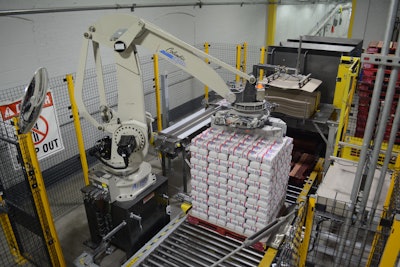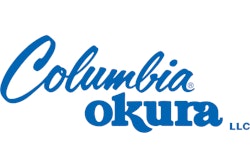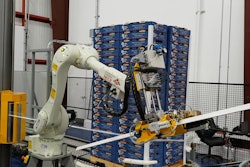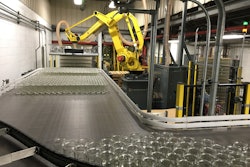There’s no question that as retail channels have expanded, packagers have had to adapt their operations in order to produce different package styles and configurations to suit individual customer needs. Michigan Sugar Company is no exception. The Bay City, MI-headquartered cooperative, which is made up of nearly 900 grower-owners that harvest up to 160,000 acres of sugarbeets each year, sells its sugar to industrial, commercial, and retail customers under the Pioneer and Big Chief brands. At its Sebewaing, MI, plant, requests from its customers for specific package formats and pallet patterns led to the installation of two robotic palletizers—one in 2010 and one in 2018.
The Sebewaing facility is one of four operated by Michigan Sugar. Approximately 925,000 tons of sugarbeets are processed annually at this location, with an average daily slice of about 5,400 tons. Each year, the factory produces about 260 million pounds of sugar, along with 12,000 tons of dried beet pulp, 130,000 tons of pressed pulp, and 36,000 tons of molasses. To package its sugar, the plant operates three bagging lines that together produce 150 bags/min.
In 2010, a request from fast-food giant McDonald’s for 4-lb bags of sugar packed in overwrapped trays led the company to replace a mechanical palletizer with a robotic system from Columbia/Okura. Having already installed a robotic palletizer from the equipment supplier at its Bay City, MI, location, Michigan Sugar was confident Columbia/Okura could meet its palletizing needs in Sebewaing as well.
Until last year, the output from all three bagging lines was palletized by the single robotic system. In 2018, Michigan Sugar installed a second system in response to a demand for retail display pallets, where individual, unbundled bags of sugar are placed on pallets in a range of patterns, according to customer requirements. “For the display pallet experience, you need the total flexibility of a robot,” says Michigan Sugar Director of Engineering Jim Martin. “You can’t do it with a mechanical system—at least not in our facility. So that’s what drove us to our second robot.”
While flexibility was a major consideration in the selection of the machinery and supplier for this application, Martin unabashedly admits that price was the main factor. “Of course, Columbia had the advantage, since we had experience with them, and they performed very well for us in the past. So there was no question mark with them as far as knowing what we’d get for the money,” he says.
What they got was an Ai1800 high-speed robotic palletizer that can accommodate bags from any one of the three lines, if need be. Although generally, as Contracted Project Engineer Robert Hite explains, it handles bags originating from two of the lines, while the legacy robot palletizes bags from the third. The new robotic palletizing system can stack whole and half pallets at speeds to 10 pallets/hr—“which is not lightning fast, but it’s reliable, and it just keeps on working,” Martin says.
Michigan Sugar is using the Ai1800 to palletize four-pound bags of sugar in pallet patterns determined by the customer. Bags exit the bagging machine in an upright position, after which they are knocked down and conveyed through a metal detector. Next, they are transported by conveyor into the robot cell, where they are divided up into two lanes into the specified number of bags needed for a pick. For example, two lanes of five bags each. The robot then picks the two lanes of bags and places them on the pallet. Each layer of the pallet is formed in the opposite direction, creating an interlocking stack.
To hold the bags securely during picking and placing, the robot is fitted with an end-of-arm tool comprising two paddles that measure approximately 48 in. long and 8 in. high. One of the paddles is stationary, while the other moves to squeeze the two side-by-side rows of bags together.
As Martin explains, one of the improvements Columbia/Okura made on the design of the robot is that the original EOAT used three paddles, with the third positioned in the middle of the two rows. Removing the third paddle provided two benefits. “First, when you get rid of that intermediate paddle, when it comes time to lift the robot away from the pallet, you don’t get any rub against the bags that would cause them to tweak. Second, it allows you to pack the bags side-by-side, very close together, which is very important when you’re creating interlocking rows. You get a much tighter pallet,” Martin says.
However, palletizing individual bags of sugar is like creating “a stack of marbles,” he adds. Interlocking rows help, but the other tool Michigan Sugar uses is coating the bags with a tacky, anti-skid coating that causes them to stick together on the pallet, rather than slip off.
Another improvement to the robot made by Columbia/Okura is its ability to create half pallets as if they are whole ones. “When you are doing a whole pallet, you can pick 10 bags at a time, but on a half pallet, when you are going in the cross direction, because you want those interlocking layers, you can only pick two or three bags at a time,” explains Martin. “So that involves a whole bunch picks to go and marshal these products.
“That’s one of the big things Columbia did for us—they found a way to do the cross picks across two pallets as if they are a whole one, and then split them apart. We didn’t think that was possible, but they showed us how to do that.”
Confirms Rob Clark, Director of Communications and Community Relations for Michigan Sugar, “It saves an incredible amount of pick time when building the pallets.”
As for programming the new robot, one of the things Michigan Sugar learned from its experience with the first robot is that it’s very easy, with a touchscreen interface offering user-pattern programming and easy operation. Says Martin, “You just have to tell it what your end product will be, and the robot figures it all out from there. It’s super simple to learn.”
Adds Hite, “The robot allows us to tweak and adjust the running conditions as we change the product and the bags we get from our suppliers.”
Though the robot is “super simple,” with each of its two new robotic palletizing systems at the Sebewaing plant, Michigan Sugar sent a team of people from its plant, including mechanics and electricians, to participate in the Factory Acceptance Tests at Columbia/Okura’s facility. “I think that was a key thing that gave those guys ownership of the systems. When they got back, they were the experts, and they made sure the systems worked,” says Martin. “Columbia/Okura took the extra time to talk each person through what they were looking at. We really appreciated that.”
And, having ownership of palletizers has proven a positive experience for the plant overall. Says Michigan Sugar Executive Vice President Jim Ruhlman, “At Michigan Sugar Company, we like to say our sugar is ‘Packed with Pride,’ and the morale boost of creating a state-of-the-art pallet is huge out in Sebewaing. There is an inherent benefit for the workforce when you have high-quality equipment putting out a high-quality product.”
Read the full article, "Packagers Realize ROI with Robotics," here.



























